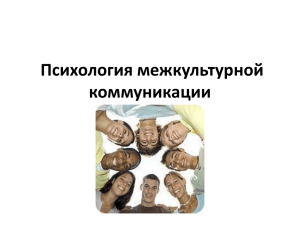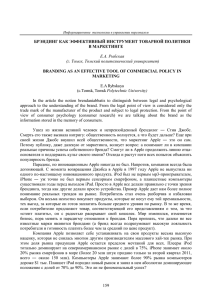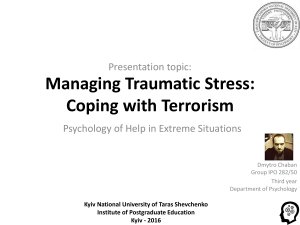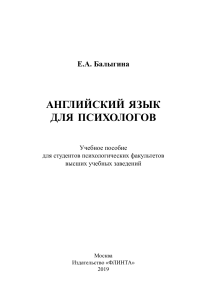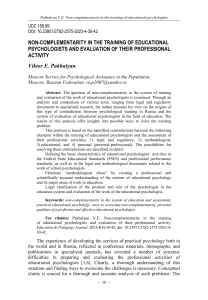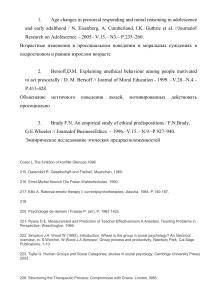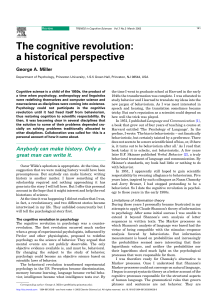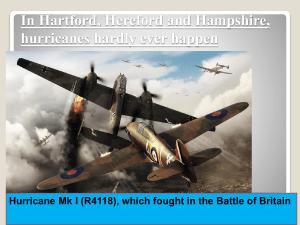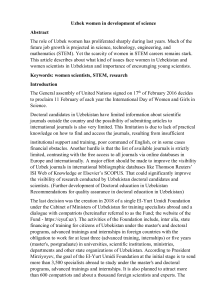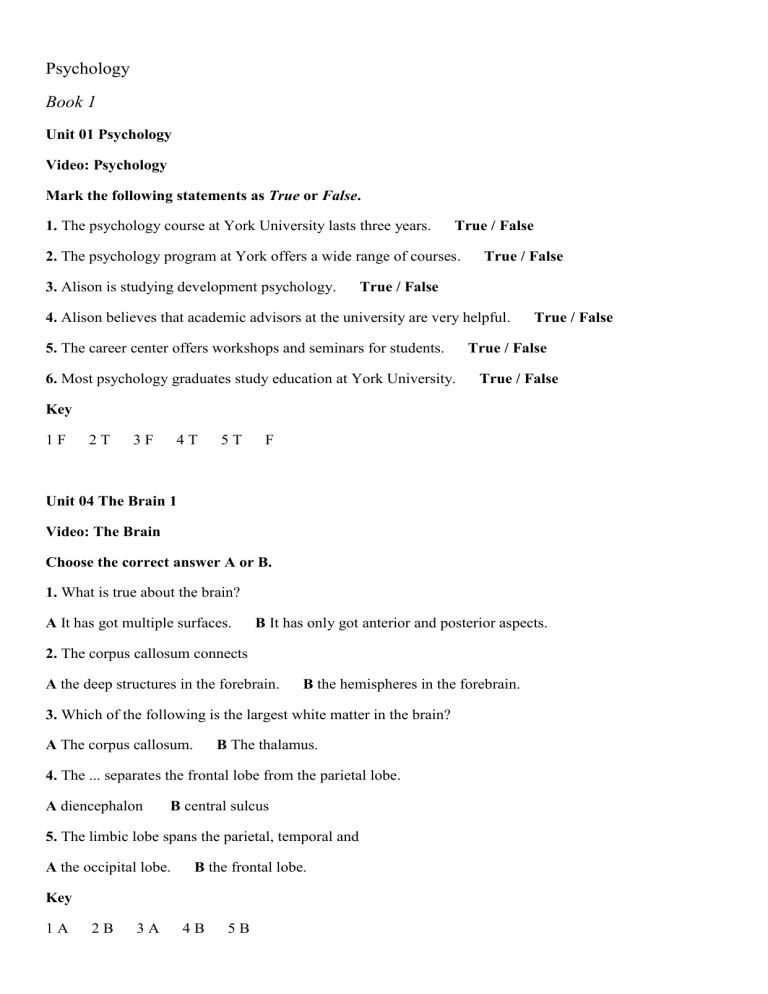
Psychology Book 1 Unit 01 Psychology Video: Psychology Mark the following statements as True or False. 1. The psychology course at York University lasts three years. True / False 2. The psychology program at York offers a wide range of courses. 3. Alison is studying development psychology. True / False True / False 4. Alison believes that academic advisors at the university are very helpful. 5. The career center offers workshops and seminars for students. 6. Most psychology graduates study education at York University. True / False True / False True / False Key 1F 2T 3F 4T 5T F Unit 04 The Brain 1 Video: The Brain Choose the correct answer A or B. 1. What is true about the brain? A It has got multiple surfaces. B It has only got anterior and posterior aspects. 2. The corpus callosum connects A the deep structures in the forebrain. B the hemispheres in the forebrain. 3. Which of the following is the largest white matter in the brain? A The corpus callosum. B The thalamus. 4. The ... separates the frontal lobe from the parietal lobe. A diencephalon B central sulcus 5. The limbic lobe spans the parietal, temporal and A the occipital lobe. B the frontal lobe. Key 1A 2B 3A 4B 5B Unit 08 Biological Rhythms Video: Circadian Rhythms Use the words below to complete the text. cells biological body nerve natural cycle schedule photosensitive The circadian rhythms are twenty four hour cycles of 1) _________ processes that exist in every living thing. They keep the body always functioning on 2) _________, day and night. The 3) _________ retinal ganglion cells are responsible for this happening. These cells send information about our surroundings through the optic 4) _________ to the suprachiasmatic nuclei. Taking light as its cue this master clock determines a continuous 5) _________ of physiological changes within our cells. But seeing too much or too little light can confuse the master clock, upset the rhythms of our 6) _________ and impact on our health and wellbeing. Disturbances to our 7) _________ rhythms put a strain on our 8) _________ and increase the risk of serious diseases including cancer, heart disease, type II diabetes and depression. Key 1 biological 2 schedule 3 photosensitive 4 nerve 5 cycle 6 cells 7 natural 8 body Unit 12 Learning Video: Learning Through Play Mark the following statements as True or False. 1. Children coming to this school center had to be familiar with the regulations of the new school setting. True / False 2. At the school center they believe that children can develop skills through play. True / False 3. Children process the world around them as they engage in conversation during play. True / False 4. The teacher is very strict when it comes to the three choices of activities on the choices board. False True / 5. The school tries to help students become resilient and persevere by giving them the skills to solve problems. True / False 6. Children here are making a lot of choices and feel strong ownership. True / False Key 1F 2T 3T 4F 5T 6T Unit 13 Intelligence Video: Multiple Intelligence Choose the correct answer A or B. 1. Which of the following two learners are better at keeping time? A Music lovers are. B Kinesthetic learners are. 2. What is not true about linguistic learners? A They learn best by seeing words. B They process knowledge through sensations. 3. Interpersonal learners are A socializers. B individuals. 4. Which of the two types of learners like self-paced instruction? A Interpersonal learners B Intrapersonal learners 5. Spatial learners are people who A use their mind’s eye when learning. B work with abstract patterns 6. Naturalists are A questioners. B observers. Key 1A 2B 3A 4B 5A 6B Revision Test Choose the correct answer. 1. The students of a(n) ... psychology program study the various functions of the brain. A environmental B behavioral C comprehensive 2. Clinical psychology teaches and prepares students to diagnose and treat mental ... . A disorders B states C processes 3. People's minds are ... by many different factors which cause them to react accordingly. A affected B assessed C designed 4. The central nervous system consists of the brain and the ... cord. A white B spinal C sensory 5. ... transmit messages to various parts of the body. A Reflexes B Cords C Neurons 6. A quick, spontaneous – usually uncontrollable – reaction to a stimulus is called a ... . A message B sensor C reflex 7. Cognition is controlled by ... matter neurons. A gray B white C sensory 8. The brain is responsible for processing and ... sensory information.. A bypassing B integrating C dividing 9. The ... nervous system includes two separate systems. A somatic B peripheral C autonomic 10. The ... division is part of the autonomic system and it functions when the body is at rest. A parasympathetic B motor C sympathetic 11. The ... nervous system handles voluntary control of body movements. A reflex B autonomic C somatic 12. Movements are controlled by the ... nerve which receives messages from the brain or spinal cord. A involuntary B motor C voluntary 13. The largest part of the human brain is the ..., which consists of two equally sized hemispheres.. A cerebrum B cortex C lobe 14. The ... lobe is responsible for hearing, speech, language learning and the formation of new memories. A frontal B temporal C auditory 15. The occipital lobe surrounds the ... cortex. A motor B somatosensory C visual 16. The ... lobe is responsible for the feeling of heat or cold that you get when you touch something. A frontal B insular C parietal 17. The body's position and movement are detected and interpreted by the somatosensory ... . A cortex B nerve C lobe 18. The part of the brain that produces and releases hormones is called the... . A cerebellum B midbrain C hypothalamus 19. Emotions are controlled by the amygdalae, which are part of the ... system. A pons B limbic C medulla 20. The hormones that control emotions and behavior are regulated by the thalamus, hypothalamus and ... gland. A callosum B ventricle C pituitary 21. A ... sends a single signal to a specific area of the body. A neuromodulator B gland C neurotransmitter 22. ... regulates the body's blood sugar levels. A Insulin B Leptin C Ghrelin 23. The glands found throughout the human body are part of the ... system. A endocrine B adrenal C neuromodulator 24. A(n) ... is a neurotransmitter produced when we sense pain or pleasure. A norepinephrine B acetylcholine C endorphin 25. Absolute and difference ... are measurements of different levels of stimulation. A thresholds B perceptions C adaptations 26. Sensory ... is the state in which a person does not get normal levels of sensory information. A transduction B adaptation C deprivation 27. Deaf people cannot use the ... of hearing. A effect B sense C perception 28. If you touch an ice-cube, you get a cold... . A sensation B variation C image 29. Through visual ..., images perceived by the eye are sent to the brain, as signals, to be interpreted. A threshold B transduction C attention 30. ... attention is the ability of the brain to focus on a particular thing, ignoring other things occurring at the same time. A Selective B Sensory C Absolute 31. A(n) ... is the smallest level of stimulation a person can detect. A difference threshold B absolute threshold C sensory adaptation 32. Delta waves, which are short and regular, occur when someone is ... . A alert B awake C asleep 33. The sleep cycle is a ... rhythm, which means it should occur every 24 hours. A circadian B ultradian C infradian 34. The ... rhythm occurs more than once a day and includes the stages of the sleep cycle. A alpha B infradian C ultradian 35. Dreams occur during the ... sleep, which is the most important sleep stage. A internal B REM C melatonin 36. When the brain is awake, thoughts in the ... are easy to recall and become part of consciousness. A subconscious B preconscious C unconscious 37. Sleepwalkers are in a(n) ... state of consciousness while sleepwalking and they cannot recall their behavior later. A relaxed B aroused C altered 38. The process used by the mind to store retrievable information in the memory begins with ... it. A encoding B processing C recalling 39. A new phone number may be stored in one's ... memory long enough to dial it and then, it may be forgotten. A short term B long term C sensory 40. One technique that helps retain information in the memory for a short time, by repeating it to oneself over and over, is called ... . A chunking B rote rehearsal C phonetic loop 41. If you stare at an image for a long time, it's maintained in the visuo-spatial sketchpad and then, it stays in the... memory longer. A echoic B explicit C iconic 42. Learning through repetition includes a process of making associations between stimuli and responses, which is called ... . A memorization B enculturation C conditioning 43. Learning how to play ball is a type of ... learning. A cognitive B psychomotor C associative 44. Children are taught the rules of living in society through the process of ... . A habituation B memorization C enculturation 45. ... groups examine things related to a person's understanding of himself or herself. A Interpersonal B Intrapersonal C Spatial 46. The ... group focuses on things related to language. A linguistic B intelligence C IQ 47. ... is the field of linguistics that studies the meanings of words. A Semantics B Morphemes C Phonemes 48. Dr. Franklin's work involves the examination of morphemes and it focuses on how sounds ... meaning. A connote B structure C denote 49. ... enjoy the company of others and they're likely to have busy social lives. A Pessimists B Extroverts C Introverts 50. If you feel that the future will be rosy, you are a person of an optimistic ... . A disposition B pattern C response Key 1C 2A C 16 C A 29 B C 42 C 3A 17 A 30 A 43 B 4B 5C 6C 7A 8B 9B 18 C 19 B 20 C 21 C 22 A 31 B 32 C 33 A 34 C 35 B 44 C 45 B 46 A 47 A 48 C 10 A 23 A 36 B 49 B 11 C 24 C 37 C 50 A 12 B 25 A 38 A 13 A 26 C 39 A 14 B 27 B 40 B 15 28 41 Book 2 Unit 03 Motivation Video: Motivation Mark the following statements as True or False. 1. The goal of people driven by theoretical motivation is to find the truth. 2. Aesthetic people are likely to become teachers and engineers. 3. Aesthetic people have a passion for beauty and harmony. True / False True / False True / False 4. Return of their investment is very important for economical people. True / False 5. People in the altruistic category become very good entrepreneurs. True / False 6. Individualistic people always seek a higher meaning in their work. True / False Key 1T 2F 3T 4T 5F 6F Unit 05 Structuralism Video: Structuralism Use the words below to complete the text. functionalism insight structure sound introspection structuralism controlled shape Wilhelm Wundt designed the first 1) _________ research in a lab which was later known as 2) _________. In this setting he studied perception. Some experiments just recorded how subjects responded to 3) _________ or the dropping of a rubber ball. He also developed 4) _________, where he asked subjects to say how they felt after dropping the ball. He believed that he could gain 5) _________ in how the human brain works. William James on the other hand attempted to explain the function of consciousness, not the 6) _________, and his approach was named 7) _________. Although these methods of research clashed, they helped improve the science of psychology and 8) _________ the methods of today. Key 1 controlled shape 2 structuralism 3 sound 4 introspection 5 insight 6 structure 7 functionalism 8 Unit 09 Cognitivism Video: Cognitivism Mark the following statements as True or False. 1. We can learn or understand something new only if we can associate it with something we already know. True / False 2. The most recently evolved part of our brain is the mammal brain. True / False 3. Our brain has the ability to control lower level functions from higher ones. True / False 4. Most of our cognition takes place in the part of our brain that our emotions take place too. 5. All the decisions we make are always made consciously. True / False True / False 6. A research showed that a decision is present in someone’s brain 60 seconds before they are conscious of it. True / False Key 1T 2F 3T 4T 5F 6F Unit 11 Evolutionary Psychology Video: Evolutionary Psychology Use the words below to complete the text. introspection functionalism shape controlled structure insight sound structuralism Evolutionary psychology claims that an understanding of the 1) _________ history of the Homo sapiens can help our understating of 2) _________ psychology. It promises a beneficial 3) _________. This means we will be able to predict and explain one set of things, behaviors, by talking about another set of things, 4) _________. It also helps to see psychology as a theory, a theory which posits the hidden causes of 5) _________ behaviors, functional forms of mental states, such as 6) _________ or desires. And the theory of evolution is that of the natural history of functional forms. So, the promised reduction is inter-theoretic, with the payoff being the improvements in the 7) _________ of psychological prediction and in the quality of the 8) _________ psychological explanation. Key 1 controlled shape 2 structuralism 3 sound 4 introspection 5 insight 6 structure 7 functionalism 8 Unit 14 Health Psychology Video: Health Psychology Mark the following statements as True or False. 1. A health psychologist only works with people in group settings. True / False 2. Health psychology can help patients learn to manage pain with non-pharmacological methods. False 3. Psychologists use meditation, mindfulness and tapping to help people. True / True / False 4. Many health psychology interventions can help people, but they do have side-effects. 5. Psychologists often help people make the changes they want in their lifestyle. True / False True / False 6. Healthcare providers can work together with health psychologists to benefit patients even more. False True / Key 1F 2T 3T 4F 5T 6T Revision Test Choose the correct answer. 1. In Plutchic's emotion ..., each emotion is represented by a different color: light green represents trust. A model B guide C wheel 2. The sense that something is going to happen is called ... and it's represented with orange in Robert Plutchic's emotion wheel. A anticipation B experience C fear 3. When unexpected things happen, people sense ... . A anger B surprise C sadness 4. ... is a mixture of sadness and disgust. A Remorse B Contempt C Anxiety 5. ... combines fear and trust. A Awe B Acceptance C Submission 6. Surprise and sadness create a feeling of ... . A contempt B disappointment C aggressiveness 7. ... is a combination of anger and disgust. A Remorse B Contempt C Optimism 8. Jillian's best friend had passed away and she was immersed in ... . A anxiety B grief C trouble 9. ... is created by either biological or emotional drives and it's a complex field of psychology. A Motivation B Regulation C Transcendence 10. According to the ... theory, people seek positive feelings avoiding negative ones. A homeostatic-regulation B arousal C opponent-process 11. ... theory focuses on biological needs, such as hunger or thirst. A Instinctive B Aesthetic C Drive 12. The theory of needs has a specific ... according to which a biological need is more important for survival than an emotional one. A field B hierarchy C response 13. The alarm stage is a period of heightened energy when the body is preparing to fight the ... . A stressor B state C response 14. People experience stress in three stages. The first stage is called ... and it fills human body with energy. A primary B alarm C exhaustion 15. ... will help you deal with stress effectively. A Secondary appraisal B Stress response C Primary appraisal 16. Structuralism maintained that mental processes should be broken down into their basic components through systematic ... . A sensation B dialectic C introspection 17. Structuralists discovered that there were flaws in ... realizing that it was not objective. A self-observation B elementary sensation C mental process 18. Functionalism focused on ..., which places importance mainly on consequences that could be actually observed. A overemphasis B pragmaticism C usefulness 19. Disinterest is an example of a(n)... process. A active B observed C passive 20. A criticism of functionalism is that it provides ... methods of research. A natural B insufficient C useful 21. Behaviorists do not deal with ... factors, such as thoughts, because they believe that behaviors are caused by stimuli in the environment. A classical B internal C operant 22. The experiments involving Pavlov's dogs are examples of ... conditioning. A classical B operant C respondent 23. Behaviorists believe that too much ... is involved in examining psychological events. A observation B reward C speculation 24. A(n) ... analysis of an experimental subject focuses on all his or her psychological functions. A multiple B holistic C individual 25. The law of ... explains why a subject would group purple objects together. A symmetry B closure C similarity 26. When a pattern is unclear, ... causes the brain to interpret it in more than one ways. A multistability B preification C emergence 27. Cognitivism is a basic ... for studying how people think. A response B interaction C framework 28. Social ... is a popular subject for experimentation. A rigor B interaction C seminar 29. A ... approach to psychology involves learning about individual mental processes. A primate B reductionist C naturalistic 30. According to Freud, ... is largely conscious and based on reality. A superego B id C ego 31. According to ... psychology, the human mind is divided into three parts. A defense B psychodynamic C primary 32. The totally unconscious part of the mind, whose main pursuit is pleasure, is the ... . A psyche B id C defense 33. ... is mostly unconscious and represents conscience and the rules of society. A Superego B Dissonance C Ego 34. Another name given to human mind by Sigmund Freud is the Greek word ... which means soul. A psychoanalysis B psyche C psychology 35. Emotional problems are caused by ... between the three parts of the human brain. A function B dissonance C division 36. According to ... selection, the mind can adapt to its environment in the same way as the body. A universal B cross-cultural C natural 37. Evolutionary psychologists support that the brain has a modular ..., which enables each of its parts to evolve towards solving a specific problem. A structure B testability C selection 38. Psychologists use a technique called ..., during which they observe a behavior trying to identify the problem it's aimed at. A function to form B form to function C natural selection 39. According to evolutionary psychologists, human behavior is mostly influenced by ... selection. A cultural B universal C sexual 40. Behavioral geneticists believe that character traits are ... . A biological B hereditary C identical 41. The reductionist approach of behavioral geneticists focuses on the effects ... have on human behavior. A studies B disciplines C genes 42. Humanistic psychology is a(n) ... branch of psychology, including elements of psychoanalysis and other areas of psychology. A unconditional B free C comprehensive 43. Margo's dream to cross the Sahara single-handed hasn't been ... yet. A actualized B embraced C overcome 44. Therapists show unconditional positive ... to their patients to make them feel accepted. A regard B limitation C potential 45. Health psychologists believe that ... factors can affect health. A comprehensive B modern C biopsychological 46. When people are stressed, their bodies release ..., which - over time - can have negative effects on health. A cortisol B illness C immunity 47. ... studies the ways in which the mind and body affect each other. A Healthcare B Illness C Health psychology 48. A scientific experiment with two groups involves the observation of the effects of a(n) ... . A testable hypothesis B independent variable C control group 49. The ... group was given the original formula of the drug whereas the experimental group was given 15% more of the ingredient. A medical B control C scientific 50. A scientist develops a(n) ... by making observations about a problem. A experiment B result C hypothesis Key 1C 2A A 16 C B 29 B C 42 C 3B 17 A 30 C 43 A 4A 5C 6B 7B 8B 9A 18 B 19 C 20 B 21 B 22 A 31 B 32 B 33 A 34 B 35 B 44 A 45 C 46 A 47 C 48 B 10 C 23 C 36 C 49 B 11 C 24 B 37 A 50 C 12 B 25 C 38 B 13 A 26 A 39 C 14 B 27 C 40 B 15 28 41 Book 3 Unit 01 Developmental Psychology 1 Video: Developmental Psychology Use the words below to complete the text. developmental advice consultation fit problems adolescent According to the clinical psychologist you distinguish 1) _________ therapy from adult therapy mostly from the 2) _________ differences and what the developmental tasks are for that group. The first piece of 3) _________ for parents debating whether to take their children to therapy is to talk with their child about what therapy means to them. The first session is a 4) _________ about what the psychologist does and how the child perceives his or her 5) _________ and what he or she wants from therapy. Finally, the clinical psychologist thinks it’s important to help adolescents understand who they are and how they can best 6) _________ in with other people. Key 1 adolescent 2 developmental 3 advice 4 consultation 5 problems 6 fit Unit 04 Social Psychology and the Individual Video: Social Psychology and the Individual Choose the correct answer A or B. 1. Why did people around the world copy the ice-bucket challenge? A To evaluate the correctness of their actions. B Because it was for a good cause. 2. According to Milgram and his colleagues people will A throw a bucket of water on themselves if other people are doing it. group of people is doing it. B start staring up at the sky if another 3. People prefer to evaluate themselves A using objective cues. B through social comparison. 4. The principle of social validation is the ... principle of influence identified by Cialdini. A third B sixth 5. What is true about the "The list technique"? A It asks people a list of requests. B It makes use of social validation. 6. What did a study carried out by Reingen show? A That students and homeowners are more likely to donate to charity. easier if a list of others did before them. B That people agree to a request Key 1B 2B 3A 4A 5A 6B Unit 10 Mental Disorders 2 Video: Depression Mark the following statements as True or False. 1. Depression is similar to sadness and it can have a great impact on your daily life. 2. A person with bi-polar disorder can feel very low, followed by a high. True / False True / False 3. Losing interest in normal activities and feeling guilty are symptoms of depression. 4. Sudden weight loss is also a sign that you are experiencing depression. 5. Depression can develop into serious mental illness if left unattended. True / False True / False True / False Key 1F 2T 3T 4F 5T Unit 13 Treatment Video: Treating Anxiety Disorders Use the words below to complete the text. education response provoking brain restructuring discomfort neutral thoughts Cognitive-Behavioral Therapy helps people with anxiety disorders face their fears. The first thing in cognitive behavioral treatment is basic 1) _________ about what is going on in a client’s 2) _________. Then psychologists ask clients to do some self-monitoring; that is to keep track of their 3) _________ and behaviors in response to a trigger. In the next meeting they rank the triggers from least to most anxiety 4) _________. And they begin the cognitive behavioral therapy with the trigger that causes the least anxiety because they want them to be successful. This is exposure and 5) _________ prevention. Cognitive 6) _________ is when clents are taught to really consider their thoughts. The goal is to create a 7) _________ response, so whatever someone may feel when they are anxious, they can tolerate the 8) _________. Key 1 education discomfort 2 brain 3 thoughts 4 provoking 5 response 6 restructuring 7 neutral 8 Unit 14 Applications Video: Clinical Psychology Mark the following statements as True or False. 1. Clinical psychology deals with people’s problems of social, cognitive and emotional functioning. False 2. At Tilburg University there is a special course on emotions and psychopathology. True / True / False 3. There is opportunity for role play in the course where students can develop their communication and interaction skills. True / False 4. Before taking a master’s in clinical psychology you must do an internship. True / False 5. Clinical psychologists can find work in big companies, the police force and mental health institutions. True / False Key 1T 2T 3T 4F 5T Revision Test Choose the correct answer. 1. ... psychology focuses on determining the changes that occur throughout a person's life. A Early B Developmental C Major 2. The first stages of a human's development start during the ... period when he or she develops into a fullygrown baby. A prenatal B early C mature 3. Motor skills start to develop during ..., which begins right after birth. A childhood B infancy C adulthood 4. Hand-eye ... is the link between visual stimuli and the movement of hands. A skill B coordination C development 5. .... occurs between the age of 10 and 12. A Adolescence B Toddlerhood C Puberty 6. The process through which humans learn to think and do various mental processes is called ... development. A sensorimotor B mental C cognitive 7. In the ... stage, children learn to communicate with words and form their own ideas. A preoperational B concrete operational C operational 8. The ... represents the relationships and interactions between a child's home and school. A microsystem B mesosystem C exosystem 9. ... theory emphasizes on the relationship between parents and children and the development of healthy relationships between family members. B Vygotsky’s Cultural-Historical A Attachment C Ecological Systems 10. ... psychology compares cultures to observe how they affect their members. A Cultural B Individualist C Cross-cultural 11. ... cultures often base communication on non-verbal methods, such as gestures. A Low-context B High-context C Polychronic 12. A ... culture, focuses on the roles of individuals within a community. A monochronic B individualist C collectivist 13. Many people often tend to feel ... towards people from different ethnic groups. A prejudice B complexity C stereotypes 14. ... psychology looks at how individuals form personal attitudes influenced by the community. A Social B Fundamental C Individualist 15. As a result of ..., people usually form better opinions of individuals than they do of groups. A fundamental attribution B person-positivity bias C cognitive dissonance 16. The ... effect causes an individual to attribute other people's behavior to their personalities, but his or her own behavior to outside factors. A social cognition B social comparison C actor-observer 17. People often prevent their own success through a psychological process called ... . A self-handicapping B self-fulfilling C attribution error 18. A student's performance may improve or deteriorate as a result of ... . A diffusion of responsibility B bystander effect C social facilitation 19. Group ... occurs among groups that share common interests. A structure B polarization C inhibition 20. When people engage in something while observed by others, they might get embarrassed owing to ... . A social inhibition B groupthink C deindividuation 21. A ... analyzes groups of people with common interests, characteristics or experiences. A descriptive research B statistical research C cohort study 22. ... allow the observation of groups over long periods of time. A Longitudinal studies B Descriptive researches C Cross-sectional studies 23. The research group are carrying out a... study, in order to determine each subject's early childhood traumas. A prospective B retrospective C casual 24. Experimental research has strict regulations which require... justification regardless of the experiment. A observational B minor C moral 25. In the event of an animal study, ... experiments are preferable to laboratory ones. A real-world B unethical C field 26. When there's a study involving minors, the university requires parental ... . A experiment B consent C benefit 27. After data is collected, it has to be characterized before it's analyzed; ... measurement ranks it in chronological order. A ordinal B nominal C ratio 28. ... is very important because it compares and contrasts the results of various similar studies or experiments. A Meta-analysis B Archival search C Content analysis 29. Clinicians use strict criteria to ... abnormal mental conditions and prescribe treatments. A level B correspond C diagnose 30. A(n) ... system of diagnosis separates patients' symptoms into several categories. A multi-axial B standardized C holistic 31. PTSD is a ... disorder that occurs after exposure to a traumatic event. A mood B stress C panic 32. Patients diagnosed with OCD suffer from ..., i.e. thoughts and ideas they cannot stop thinking about. A compulsions B obsessions C symptoms 33. Some patients exhibit periodical extreme changes of mood because they suffer from ... disorder. A depression B panic C bipolar 34. If the symptoms of schizophrenia continue, even after treatment, it becomes ... schizophrenia. A residual B undifferenciated C emotional 35. ... schizophrenia causes a person to stay completely inactive for long periods of time. A Catatonic B Paranoid C Disorganized 36. After traumatic events, some people experience ... amnesia, which causes partial memory loss. A identity B dissociative C classified 37. People with... personality disorder dislike social interaction, prefer isolation and tend to form dysfunctional relationships. A schizotypical B borderline C schizoid 38. ... personality disorder causes a person to be manipulative, hostile and deceptive. A Avoidant B Antisocial C Dysfunctional 39. A ... person feels that others constantly intend to do harm to him or her. A schizotypical B paranoid C narcissistic 40. ... personality disorder causes people to act deceitfully and jeallously and also put too much importance on themselves. A Borderline B Dependent C Histrionic 41. In cases of schizophrenia or mania, psychiatrists prescribe ... . A neurosurgery B psychosurgery C antipsychotics 42. The treatment center offers ... therapy for those who suffer from negative thinking and low self-esteem. A cognitive B humanistic C existential 43. ... therapies have a similar background. A Free B Family C Psychoanalytic 44. Interactive therapies are a real benefit to some patients, so they choose ... therapy. A behavioral B group C course 45. If students want to focus on relationships among individuals within groups, they should choose to study ... psychology. A educational B community C organizational 46. ... psychology applies to business decisions and personnel and aims to make the workplace more organized and efficient. A Industrial B Human C Legal 47. A very fascinating subfield of modern psychology is ... psychology, which deals with the system of criminal justice. A occupational B organizational C forensic 48. A(n) ... psychologist's job is to evaluate army staff before they are deployed. A empirical B scholarly C military 49. A ... psychologist must understand marketing and assess products according to popularity. A consulting B consumer C counseling 50. Dr. Maddison holds a PsyD and is employed as a(n) ... psychologist at North University. A academic B doctoral C graduate Key 1B 2A B 16 C A 29 C C 42 A 3B 17 A 30 A 43 C 4B 5C 6C 7A 8B 9A 18 C 19 B 20 A 21 C 22 A 31 B 32 B 33 C 34 A 35 A 44 B 45 B 46 A 47 C 48 C 10 C 23 B 36 B 49 B 11 B 24 C 37 C 50 A 12 C 25 C 38 B 13 A 26 B 39 B 14 A 27 A 40 C 15 28 41


